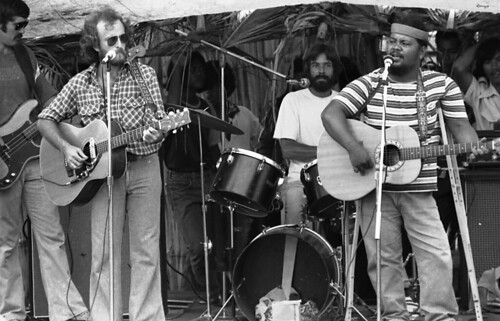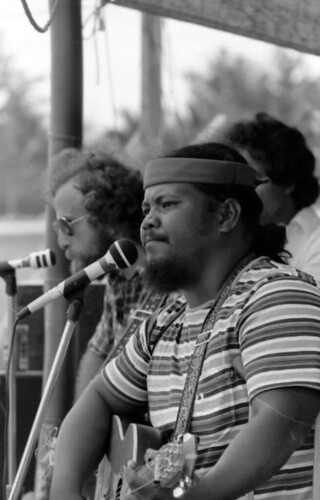Joseph “JD Crutch” Duenas
Talo’fo’fo boy
The musician “JD Crutch” was a man who was both artist and outlaw, in a manner of speaking. In order to break new ground, an artist has to defy existing laws that govern what is acceptable for the time. And Duenas did it with a vengeance, in music and his lifestyle. His voice was a blend of Rod Stewart raunch and the nasal sound of the Chamorro techas who lead prayers at Guam rosaries and novenas.
Joseph Anthony Castro “Crutch” Duenas, born 19 June 1955, was a Talo’fo’fo boy, son of Ana Castro Duenas and Jesus Duenas; who, along with Manny DeGracia, captured Japanese World War II straggler Shoichi Yokoi who had hidden for 27 years in the jungles of Guam. JD’s nickname was a nod to the fact that he had to use crutches, due to a bout with polio in his childhood.
When he was growing up, his father cut him no slack because of his disability. Duenas had to carry his own weight on the family ranch. In that regard, his dad probably did him a favor because it toughened him for the world outside. He was not one to play on anyone’s sympathy for him and didn’t bemoan his disability.
Days working at the ranch were arduous, but punctuated by the joyful sounds of Kantan Chamorita, or Chamorita, an ancient call-and-response style of singing. True Chamorrita is basically a musical and verbal shootout, with each singer trying to outgun each other with clever, and sometimes naughty, one-upmanship. Being blessed with both a sharp mind and a piercingly haunting voice, Duenas was a natural.
And sing he did. Anytime, anywhere. Sometimes he would even erupt in song in a crowded movie theater, causing both amusement and consternation in the audience. JD was indulging his passion, unwilling ears notwithstanding. His enormous charisma usually got him off the hook.
First recorded with Charfauros Brothers
In 1977 he was recording at the Charfauros Brothers recording studio along with Jesus and Tommy Charfauros’ Programma Chamorrita radio show on KUAM. The early recordings for the radio show evolved into Duenas’s first record album Guinaifen Manglo. His uncle Roque Mantanona, a boxer/poet, wrote most of the lyrics and Duenas would supply the chords and melodies. The backup musicians for most of the songs on that album were Joe Taimanglo on bass and guitars, Rick “Tuan” Camacho on drums and Joe “Uncle Tote” Cunningham on flute and conga.
Two of the songs were a collaboration with the band Tugboat: “Maseha Hafa Taimano,” one of his original songs, and “Ti Hu Ta’lo Dumingu,” a translation of the Cecilio & Kapono song “Home”, boasted the strong rhythm section of John Needham, Mike Homfeld on bass and Harry Perrin on drums. It was those two songs that led Duenas, and for that matter, Chamorro music as well, in a meatier new direction.
The album was a little bit raw, but that was part of its charm. A Guamanian country and western recording artist (who shall remain nameless) actually wrote a letter to the editor of the local newspaper bashing the album, saying he thought it was a disgrace that anyone could “just come out of the jungle and make a record album.” The musicians took it as a compliment, and an indication that they were on to something fresh. It’s important to note that the country singer is now lost in obscurity while JD Crutch’s name is legend.
Not too long after Guinaifen Manglo was completed, Duenas joined forces with Tugboat, Chuck McJohn, Frank Reyes and Cunningham to collaborate on the Marianas Homegrown album as well as an occasional concert. They opened for Cecilio & Kapono’s first Guam concert in front of 8,000 fans at the former Greyhound Race Track. Cecilio said later that when he heard Duenas sing the translation of “Home”, he turned to Henry Kapono and said “They do it better than we do.”
After Tugboat left for the mainland to try to get a foot in the door of a bigger market, those who stayed occupied the Guam vacation home/recording studio of Katsuo Ohno, a Japanese composer. The studio was in the Windward Hills golf course community, and was originally built by Mike Homfeld’s dad. It was there that they recorded three of the Marianas Homegrown songs, two of which featured Duenas.
In the process, The Ga’ga Brothers were born. Ga’ga is the Chamorro word for animal, somehow appropriate for the psyche of the group. The band consisted of Duenas, Chuck McJohn, Giuseppe Bossi and Bruce Reynolds, DDS on guitars and vocals, Fil “Film” Batol on bass and Cunningham on drums. Cunningham was caretaker for Ohno’s studio, which he only used a few weeks out of the year, and so the place became the group’s headquarters for rehearsing.
After Homegrown was released, they started recording at Ike Charfauros’ studio as a band to produce Duenas’s second album, Hu Apreba Na Bonita. It was then that Duenas started to find his true rock and roll calling, as defined by the song “Ti Yahu Y Yokui Stone,” a rollicking shuffle with a burning harmonica solo by Fil Batol.
During that period they played a lot of parties, but also had a regular Friday night gig at a place called Lilly’s Place in Hagåtña, Guam. Lilly was a charming Korean lady who ruled over what was essentially a roadhouse bar full of rowdy locals and military dudes when Duenas and the band played there. On the nights the band got particularly hammered they called themselves The Balacho Bob Band (balacho being the Chamorro word for drunk): Joe Bob Crutch, Chuck McBob, Dr. Bob, Bossi Bob, Film Bob and Joe, Uncle Bob.
Pala-pala circuit
While playing at the bar was fun, the best gigs were the local parties; the palapåla circuit. Palapåla is Chamorro for canopy or makeshift shelter used for a party. If there’s one thing Guam folks know how to do, it’s engineer a big party, which generally includes both a DJ and a live band. And because “JD Crutch” was a household name by then, he always drew a crowd. One great example was a small party in his home village Talo’fo’fo at the home of one of Duenas’s relatives. The band set up on top of two 4-by-8 sheets of plywood under a tin roof, and the whole yard was jumping to the music. Even the older ladies in the outdoor kitchen were banging on the big cooking pots with spoons keeping time to “Ti Yahu Y Yoku Stone.”
Duenas’s band also did a few road trips to the neighboring Mariana Islands: Rota and Saipan. It was on their first trip to Rota to play for a big wedding party that the song “Rota Buds” was born. The line in the song where the cop mentioned getting busted in Rota for not having any weed is a true story.
By the late ’80s The Ga’ga Brothers had disbanded, and Duenas was performing mostly solo, and occasionally with other bands. He recorded one album in Manila, with studio musicians. While it lacked the edge of the Ga’gas, his voice still made the music worth hearing.
He eventually made a deal with Jimmy Dee to release his earlier music under the Napu label, selling his rights for a mere $3,000, which he blew within a couple of weeks. Jimmy Dee repackaged the album Hu Apreba Na Bonita with “Bente Uno Yo’ Gi Preso” and “Apo Magi gi Apagahu” from Marianas Homegrown and released the CD under a different title saying that the music was recorded at his studio. Duenas recorded three final albums at Jimmy Dee’s and his music continues to sell and be heard.
Died in 1996 at age of 41
Duenas died on 12 December 1996 on Guam at the age of 41, of internal bleeding. He had been married three times (Linda McCarrel, Debbie Kamminga and Debra Shackleton) and left ten children – Toby, Lillian, Deedee, Joe Leon, Jesse, Ann, Sirena, Alexis, Josephine and Cassidy.
By Joe “Uncle Tote” Cunningham
For further reading
I Manfåyi: Who’s Who in Chamorro History. Vol. 2. The Hale’-ta Series. Hagåtña: Political Status Education and Coordinating Commission, 1997.


